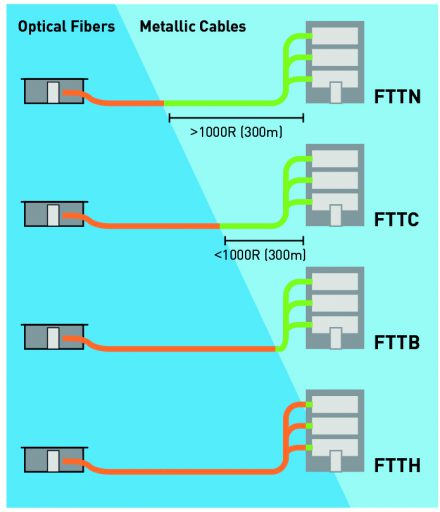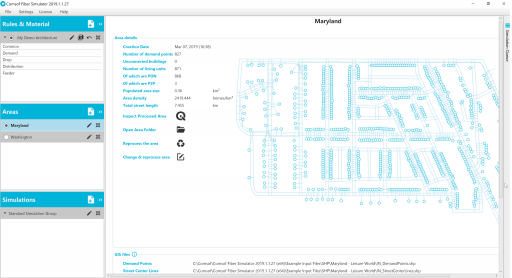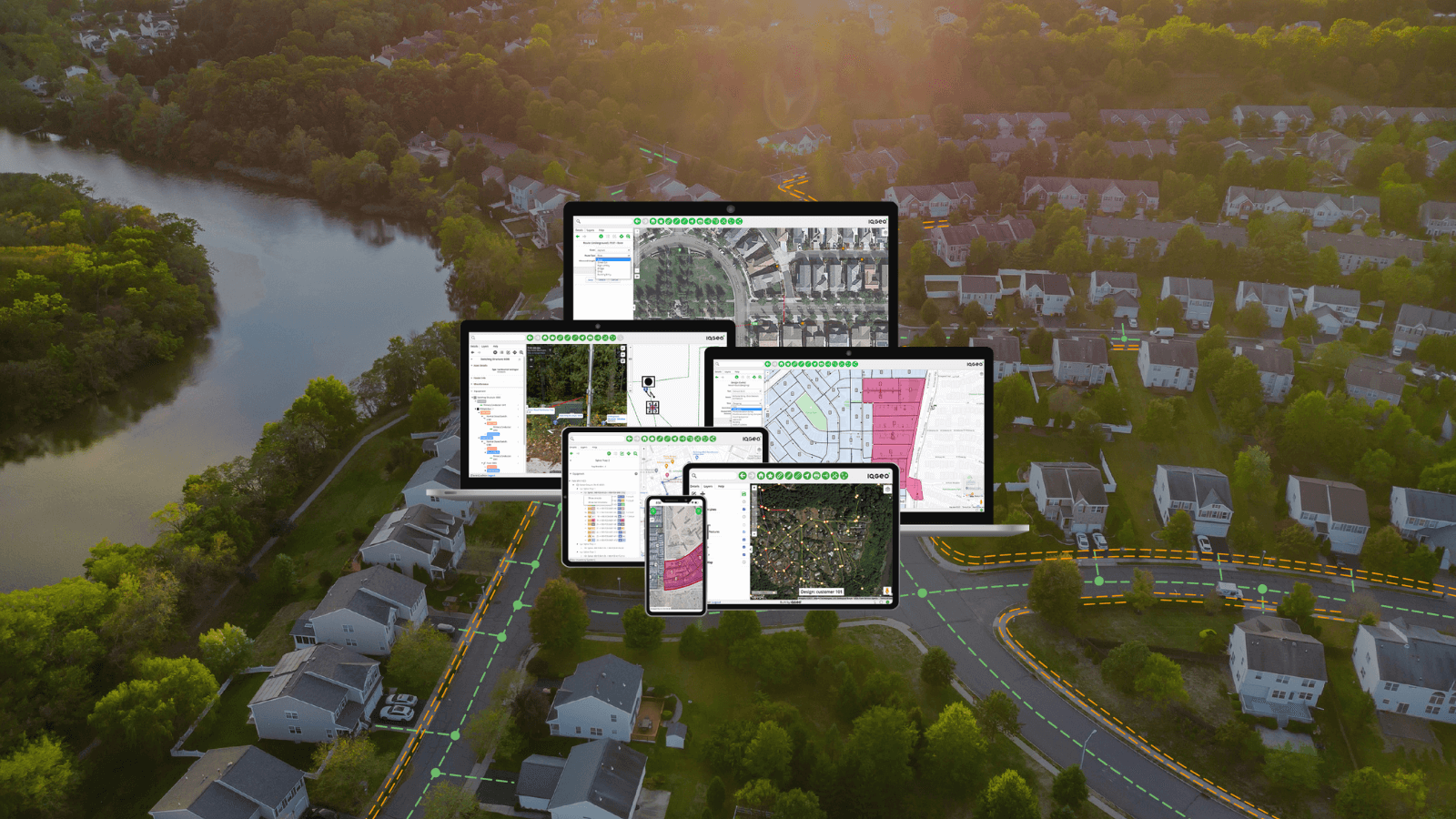まず、FTTxとは何か?FTTx(Fiber to the x)とは、ラスト・マイル接続に使用される回線の全部または一部をユーザーに提供するブロードバンド光ファイバー・ネットワーク・アーキテクチャに使用される一般的な用語です。FTTxは、ファイバー配備のさまざまなバージョンに使用される総称です。これらの構成は、ファイバーの終端位置に基づいて分類されます。
現在最もよく使われているファイバーネットワーク用語:
- ファイバー・ツー・ザ・ホーム(FTTH)またはファイバー・ツー・ザ・プレミス(FTTP):光ファイバーの終端は、居住空間が始まる場所である。例えば、住宅の外壁にあるボックス。これは完全なファイバー接続です。
- ファイバー・ツー・ザ・ビル(FTTB):ファイバーは建物の境界で終端する。例えば、アパートの地下にあるボックスなど。
- ファイバー・ツー・ザ・ノード(FTTN):この場合、ファイバーは街路キャビネットで止まり、顧客宅から数キロ離れていることもある。ラストマイルの接続は同軸です。
- FTTC(Fiber to the Curb or Cabinet):これはFTTNに似ているが、ファイバーは1マイル未満の、より敷地に近いキャビネットまたはボックスで終端される。ラストマイルの接続は銅線である。
- ファイバー・トゥ・ザ・アンテナ(FTTA):これはアンテナにファイバーを給電するものである(ファイバーバックホールとも呼ばれる)。FTTAアーキテクチャは、5Gの高帯域幅要件に対応するために必要です。

なぜFTTxの計画と設計が重要なのか?
x ネットワークへの光ファイバーの敷設は、費用と時間のかかるプロセスです。1軒あたりのコストは、ファイバーをどれだけ家庭に近づけるか、また地域の密度によって大きく異なります。1軒当たりのコストは、数百ドルから数千ドルの間で変動します。大規模なプロジェクトの場合、 FTTxネットワークの構築とメンテナンスのコストは数十億ドルに上ることもあります。
そのため、戦略的な決定と最適な設計を行うことが、予算を最適化するための重要なステップとなります。FTTxネットワークの計画と設計のプロセスは、大まかに3つの段階に分けることができ、それぞれの段階にはそれぞれの目的と成果があります。
これらのステージは以下の通りである:
-
戦略的ネットワーク計画
-
ハイレベル・ネットワーク設計
-
ネットワークの詳細設計
戦略的ファイバー・ネットワーク計画の始め方
FTTxプロジェクトは戦略的ネットワーク計画から始まる。ビジネス上の意思決定のほとんどはこの段階で行われる。ここで事業者は、以下の質問に対する答えを見つける必要がある:
-
どのようなネットワークを展開したいのか?
-
どこに配備しようか?
-
いつ配備すべきか?
上で見たように、FTTxにはさまざまな展開形態がある。また、1つの形態であっても、多くのアーキテクチャを決定する必要がある。
プランナーはまず、FTTxネットワークの導入コストを見積もる。複数のエリアで異なるトポロジーとアーキテクチャを比較する。そうすることで、複数のエリアでどのネットワークルールが最も適しているかを判断する。
また、投資収益率も評価する。これには、光ファイバーを使った接続にお金を払いたいと考える人の割合や、ユーザー一人当たりの平均的な月収予想などのマーケティング・データを使う。彼はこれらの数字をできるだけ正確に把握する必要がある。
従来、彼はビジネスケースを作成するために、手書きのデザインとスプレッドシートの計算を信頼していた。そしてこの情報を最高レベルの意思決定者に提示する。
エクセルやその他の描画ツールを使用することは、費用対効果の高い解決策に見えるかもしれないが、時間がかかり、ミスが起こりやすいことがわかる。ミスは非常に高くつく可能性があるため、この段階、そしてすべての段階において正確さが鍵となる。展開コストや予想される普及率を過小評価すると、プロジェクトが失敗に終わることもある。
ファイバー配備の自動化計画ソリューション
今日、多くの自動化され最適化された FTTxネットワーク・プランニング・ツールが利用可能です。これらのツールはプランニングの手順を迅速化し、正確なコスト見積もりを提供します。
これらのツールは、対象地域の地理情報システム(GIS)データを 使用し、ユーザー定義のネットワーク・ルールに基づいて自動的にネットワークを設計する。これらのルールには、すべてのネットワーク要素の人件費と材料費、ネットワークアーキテクチャの説明が含まれています。この情報に基づいて、ソフトウェアは視覚的なネットワーク設計を生成し、広範な部品表を提供します。

このようなツールを使えば、複数のエリアについて並行してシミュレーションを行うことができる。あるいは、同じエリアに複数のルールを適用し、同じ画面上で直接比較することで、異なるシナリオの結果を評価することもできます。マーケティングデータを使ったROI計算と同様に、正確なハイレベルのコスト結果を提供します。
これらの計算の正確さと詳細さは、リスクを大幅に低減する。また、プランナーは時間を節約し、単調な作業を排除し、コントロールしながらも、プロセス全体をミスのないものにすることができる。
自動化された計画および設計プロセスの利点と、IQGeo がファイバー・ネットワークの ROI を最大化するためにどのように役立つかをご覧ください、 デモのご予約当社の業界エキスパートによるデモをご予約の上、当社のエンドツーエンドのファイバー・ネットワーク管理ソフトウェアを実際にご覧ください。
Comsof Fiberは、 、光ファイバーネットワークを迅速かつコスト効率よく拡張したいと考える通信事業者やエンジニアリング会社向けに、自動化された光ファイバー計画・設計ソフトウェアをリードしている。


 前へ
前へ







